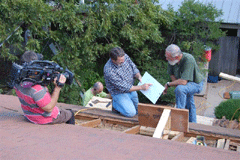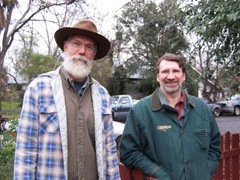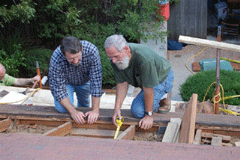This Old (Green) House
Air Date: Week of February 2, 2007

Norm Abrams (left) and Bill Moore (right) working behind the camera. (Photo: Joey Shebesta)
“This Old House” goes to Austin, Texas to renovate an old bungalow the eco-friendly way. The home restoration show’s master carpenter, Norm Abrams, and head builder, Bill Moore, tour the house with host Steve Curwood and talk about why green building makes environmental and economic sense.
Transcript
CURWOOD: It’s Living on Earth. I’m Steve Curwood
[THIS OLD HOUSE THEME: Peter Bell “This Old House Theme Music” from ‘This Old House’ (Production Trax – 2006)]
CURWOOD: “This Old House” has been a staple of American public television for more than 20 years. The program nearly invented the now popular genre of do-it-yourself home improvement shows. And the show just hit the big 5-0, its 50th project. For the first time, its hosts are remaking a house entirely in green. It’s a 1926 bungalow in Austin, Texas.
And when it’s done, it’ll be a showcase in sustainable building and energy conservation technologies. Norm Abram is the master carpenter on “This Old House” and Bill Moore has been doing green construction in the Austin area for 20 years. They join us now from the building site in Austin. Norm just exactly where are you guys now?
ABRAM: We’re standing right out in front of the house. Fortunately it stopped raining so we’re not getting drenched today.

Bill Moore (left) and (right) Norm Abram (Photo: Deborah Hood)
ABRAM: Well, just yesterday in fact, they put in a water collection tank. And what they will be doing is collecting water at the gutters. The rainwater will be collected in the gutters, at the eves of the house, and go to a tank that holds about 1200 gallons of water and that will be able to be stored and used for irrigation purposes.
CURWOOD: Bill, tell me um, what else is green on the building site there? You have rainwater management. What about the lawn?
MOORE: Well, there’s not going to be very much lawn. It’s also going to have a lot of natural or native plants put in so there will be less water needed. That’s one of the things we tried to concentrate on here because we’re always trying to conserve water here.

Norm Abram (left) and Bill Moore (right) working behind the camera. (Photo: Joey Shebesta)
MOORE: Hopefully nothing. Green is not supposed to be something that is unusual. It’s supposed to be, what we’ve been trying to do is make it mainstream. So when you’re looking at the house you just see a nice sort of craftsman bungalow house. That has, the only difference might be is it’s got a nicer metal roof on it.
CURWOOD: Why don’t we take a look inside and see what kind of green magic you’ve done in there.
[CONSTRUCTION SOUNDS]
CURWOOD: The green points for all of this are the bedroom is tiny so that’s saving space and saving consumption.
ABRAM: Exactly.
CURWOOD: And ah…
ABRAM: Very energy efficient windows, reclaimed wood on the floor of the, ah, bedroom. The decking on the deck is a material that’s made out of old plastic bags and wood fiber. So it’s some more material that’s been recycled. And when the kitchen was redesigned, the footprint is no bigger than it was before. The appliances will be more efficient. The cabinets, the new cabinets that are being built, they used MDF, medium density fiber board, for the casings. And used lyptus, which is a very renewable wood that not too many people know about, for the face frames of the cabinets and so forth.
CURWOOD: So, Bill, what makes a house green among other things is energy efficiency. What are the things in this house that make its energy systems especially green?
MOORE: Well, we put in a lot of insulation in the addition and we insulated the lower floor, which hadn’t had any before.
CURWOOD: Now what about a source of energy? You got any wind, solar, geothermal?

Norm Abram (left) and Bill Moore (right) help a roof go green. (Photo: Joey Shebesta)
MOORE: There is a photovoltaic array on the roof that’ll supply probably 20 percent of the electrical use of the house during the year.
CURWOOD: Why so modest?
MOORE: We actually only had that much roof available that was facing the proper direction and then they just covered that amount.
CURWOOD: At the end of the day what’s it going to cost energy wise compared to what it was running before?
MOORE: What they’re hoping is, the house was increased in size from about 1500 to 2400 or 2300 something like, and but the energy use will probably go down about 40 percent.
CURWOOD: That’s a pretty good deal.
MOORE: Yeah.
CURWOOD: What about the resale side? I know these people, of course, they expect to live there forever. But if they were to sell what kind of financial advantage or disadvantage does greening a house provide when it comes to resale time?
MOORE: Well, uh greening a house a lot of that is just simply building it better. So here if you had a nice house and the price wasn’t outrageous and it was very well built then it would tend to sell much faster. You might not get all of your money back immediately but it would easily sell much faster than anything of comparable size in the area. And if you lived in it long enough you would recoup a lot of your investment because of the savings of energy and water and uh since it’s built better you’d have less maintenance also.
CURWOOD: Norm Abram I’ve got a question for you. “This Old House” has aired for 28 seasons now why go green? Or another way to put it: what took you guys so long?
ABRAM: Well, actually Steve you know we’ve been green for quite some time. Ah, I think “This Old House”, if you look at us historically, there’s a lot of things that we’ve been doing that make us green. We’ve been very conscious of energy efficiency and good insulation, good windows, um, you know using good materials. We recycle materials on our older historic houses and so forth. So, we’ve been green to some level. The reason we came to Austin was because, you know they’ve been working on the idea of green for about 40 years now. And you know, we wanted to go to the place where we felt it was strong and it began and we could get some good lessons. And some of the information that we have here will not only benefit our viewers but it’s going to help us. And when we go back to New England, um, we’re learning something new as well. And we’ll try to be more green in our building
CURWOOD: Norm Abram is the master carpenter on “This Old House” and Bill Moore has been doing green construction in Austin for about 20 years. On February 8th This Old House will broadcast the first of eight episodes on their renovation project there in Austin. Gentlemen thank you both for being on the show.
MOORE: Thank you Steve.
ABRAM: Thank you.
Links
Living on Earth wants to hear from you!
Living on Earth
62 Calef Highway, Suite 212
Lee, NH 03861
Telephone: 617-287-4121
E-mail: comments@loe.org
Newsletter [Click here]
Donate to Living on Earth!
Living on Earth is an independent media program and relies entirely on contributions from listeners and institutions supporting public service. Please donate now to preserve an independent environmental voice.
NewsletterLiving on Earth offers a weekly delivery of the show's rundown to your mailbox. Sign up for our newsletter today!
 Sailors For The Sea: Be the change you want to sea.
Sailors For The Sea: Be the change you want to sea.
 The Grantham Foundation for the Protection of the Environment: Committed to protecting and improving the health of the global environment.
The Grantham Foundation for the Protection of the Environment: Committed to protecting and improving the health of the global environment.
 Contribute to Living on Earth and receive, as our gift to you, an archival print of one of Mark Seth Lender's extraordinary wildlife photographs. Follow the link to see Mark's current collection of photographs.
Contribute to Living on Earth and receive, as our gift to you, an archival print of one of Mark Seth Lender's extraordinary wildlife photographs. Follow the link to see Mark's current collection of photographs.
 Buy a signed copy of Mark Seth Lender's book Smeagull the Seagull & support Living on Earth
Buy a signed copy of Mark Seth Lender's book Smeagull the Seagull & support Living on Earth

